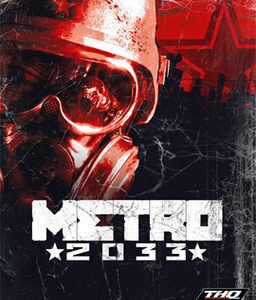If you’re looking for a unique setting and a haunting vision of the apocalyptic future our world is headed toward, then look no further than Metro 2033, a survival-horror-style FPS from 4A Games. Based on the Russian novel by Dmitry Glukhovsky, Metro 2033 puts players in the role of Artyom, a young Russian born just before Moscow was plunged into an endless nuclear winter.
Players will take Artyom across Moscow’s massive and broken subway system to deliver an important message to a neighboring station. The Metro is where people have retreated to and set up scattered towns beneath the city. It is their only means of survival from the poisonous air and mutants on the surface. And it’s in this world, ravaged by nuclear fallout, that Artyom will face horrendous mutants, haunting ghosts, toxic air and even Nazis along his journey.
Metro 2033‘s best quality is its atmosphere. Few FPS manage to capture an enthralling atmosphere like Metro 2033. The sense of despair, impending death, and fear of the unknown will grip you from beginning to end, and it’s easy to spot some similarities to games like BioShock, Fallout 3, and Half-Life 2. Unfortunately, the gameplay in some areas will prevent it from being remembered in the same way as those classic titles.

The stealth sections in particular, which the player must complete through trial and error, are incredibly frustrating. The problem here is that the enemies don’t seem to follow consistent rules. This means that the same tactics don’t work every time, and sometimes enemies will behave in ways that don’t make sense. Guards will occasionally see you no matter how well you’re hidden, but can be oblivious when you kill someone standing right next them. Throwing knives, which seem to be the most effective way to kill people instantly, will randomly bounce off guards or just completely miss them, resulting in every enemy being instantly aware of your presence.
Metro 2033‘s difficulty can also be very unforgiving at times, which may be intentional due to the game’s setting. After all, in a world consumed by nuclear fallout, mutants, and people willing to kill you on sight, how much help could you really expect? But there are some scripted moments where if you don’t do exactly what the game wants you to, you’ll die instantly without really knowing what you did wrong. I encountered quite a few instances where I died without warning, especially during the last third of the game. It’s also during this part of the game that players will have to spend an unusually long period of time on the surface, wearing a gasmask. If you haven’t been carefully searching bodies leading up to this part and stocking up on gasmask filters, there’s a good chance you won’t be able to make it through this section of the game without going back a couple of chapters. So, word of advice: search every dead body you come across and always make sure you carry a good amount of filters on your virtual person at all times.
Lastly, some of the game’s mechanics are not explained well, like the currency system. Since ammunition is your money, it would’ve been nice to be able to easily distinguish which type of rounds were which, and what types were more valuable. The game does inform the player early on that pre-apocalypse, military-grade rounds are worth a lot more and do more damage than the “dirty” rounds made in the Metro, but they all look almost identical. Throughout most of the game, I had no idea which type of ammunition I was firing or spending in the various stores. But again, this may have been something done intentionally by the developers to reinforce the game’s harsh, unforgiving tone.
These flaws aside, Metro 2033 still provides an experience that I’ll carry with me for a long time. Along with the amazing atmosphere mentioned earlier, there are some scripted moments, intense shoot-outs and on-rails sections that are brilliant. The pacing throughout Metro 2033 is also quite good, with a great mixture of quiet downtime, building suspense, and moments of pure adrenaline.
4A Games should also be commended for doing some excellent work with lighting and smoke effects. The way these elements are used and combined really sell Metro 2033‘s atmosphere, and help create a world that is intriguing and oppressive, beautiful and filthy all at the same time. Your heart will stop beating the first time you notice your flashlight casting a ghost’s shadow on the wall, you’ll hold your breath during ambushes from mutants, and you’ll feel downright sorrow as you hold a smoking pistol over a fallen Russian’s body. Yes, even after the apocalypse, there is no shortage of people killing one another in the Metro.
So if visions of a post-apocalyptic world interest you, and if you can handle some frustration and unforgiving difficulty along the way, then Metro 2033 is absolutely worth your time. With an interesting setting like the ruined subway beneath Moscow, a pervasive atmosphere and superb pacing, Metro 2033 stands out as one of the more unique FPS on the Xbox 360. While it won’t be remembered along with classic titles like BioShock, Fallout 3, and Half-Life 2, those who play it and experience what it has to offer will likely remember it fondly.


















